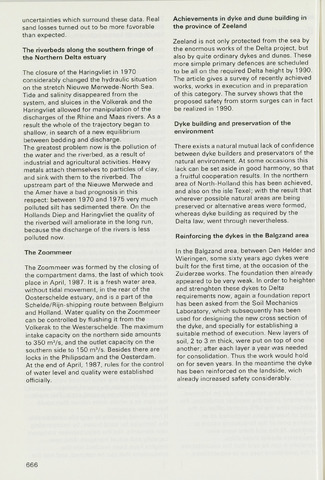uncertainties which surround these data. Real
sand losses turned out to be more favorable
than expected.
The riverbeds along the southern fringe of
the Northern Delta estuary
The closure of the Haringvliet in 1970
considerably changed the hydraulic situation
on the stretch Nieuwe Merwede-North Sea.
Tide and salinity disappeared from the
system, and sluices in the Volkerak and the
Haringvliet allowed for manipulation of the
discharges of the Rhine and Maas rivers. As a
result the whole of the trajectory began to
shallow, in search of a new equilibrium
between bedding and discharge.
The greatest problem now is the pollution of
the water and the riverbed, as a result of
industrial and agricultural activities. Heavy
metals attach themselves to particles of clay,
and sink with them to the riverbed. The
upstream part of the Nieuwe Merwede and
the Amer have a bad prognosis in this
respect: between 1970 and 1975 very much
polluted silt has sedimented there. On the
Hollands Diep and Haringvliet the quality of
the riverbed will ameliorate in the long run,
because the discharge of the rivers is less
polluted now.
The Zoommeer
The Zoommeer was formed by the closing of
the compartment dams, the last of which took
place in April, 1 987. It is a fresh water area,
without tidal movement, in the rear of the
Oosterschelde estuary, and is a part of the
Schelde/Rijn-shipping route between Belgium
and Holland. Water quality on the Zoommeer
can be controlled by flushing it from the
Volkerak to the Westerschelde. The maximum
intake capacity on the northern side amounts
to 350 m3/s, and the outlet capacity on the
southern side to 1 50 m3/s. Besides there are
locks in the Philipsdam and the Oesterdam.
At the end of April, 1987, rules for the control
of water level and quality were established
officially.
Achievements in dyke and dune building in
the province of Zeeland
Zeeland is not only protected from the sea by
the enormous works of the Delta project, but
also by quite ordinary dykes and dunes. These
more simple primary defences are scheduled
to be all on the required Delta height by 1 990.
The article gives a survey of recently achieved
works, works in execution and in preparation
of this category. The survey shows that the
proposed safety from storm surges can in fact
be realized in 1990.
Dyke building and preservation of the
environment
There exists a natural mutual lack of confidence
between dyke builders and preservators of the
natural environment. At some occasions this
lack can be set aside in good harmony, so that
a fruitful cooperation results. In the northern
area of North-Holland this has been achieved,
and also on the isle Texel; with the result that
wherever possible natural areas are being
preserved or alternative areas were formed,
whereas dyke building as required by the
Delta law, went through nevertheless.
Reinforcing the dykes in the Balgzand area
In the Balgzand area, between Den Helder and
Wieringen, some sixty years ago dykes were
built for the first time, at the occasion of the
Zuiderzee works. The foundation then already
appeared to be very weak. In order to heighten
and strenghten these dykes to Delta
requirements now, again a foundation report
has been asked from the Soil Mechanics
Laboratory, which subsequently has been
used for designing the new cross section of
the dyke, and specially for establishing a
suitable method of execution. New layers of
soil, 2 to 3 m thick, were put on top of one
another; after each layer a year was needed
for consolidation. Thus the work would hold
on for seven years. In the meantime the dyke
has been reinforced on the iandside, wich
already increased safety considerably.
666

